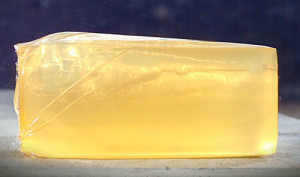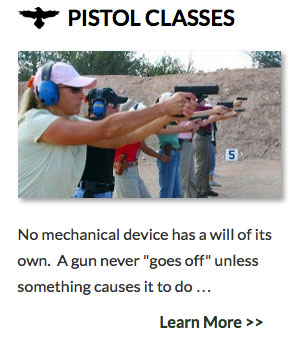Widgetized Section
Go to Admin » Appearance » Widgets » and move Gabfire Widget: Social into that MastheadOverlay zone
The Problem with Stopping Power
 I have long been fascinated with the topic of handgun stopping power. For almost 25 years, I read everything I could on the topic. I went to autopsies, spoke with coroners and emergency-room physicians, interviewed people who had shot others in self-defense, pursued shooting reports from many law enforcement agencies, and I even wrote my master’s thesis on the topic. After all of this, you’d think I’d have a good handle on the subject, but I don’t. Many look to the ballistics laboratory for a definitive answer, but a human’s resilience can t be recreated in a block of ballistics gelatin. Actual shooting data? Sounds like a fine idea, but for every successful shooting with a particular load/caliber I uncovered, I found one or two others where it performed miserably. Handgun stopping power a problem? Most certainly.
I have long been fascinated with the topic of handgun stopping power. For almost 25 years, I read everything I could on the topic. I went to autopsies, spoke with coroners and emergency-room physicians, interviewed people who had shot others in self-defense, pursued shooting reports from many law enforcement agencies, and I even wrote my master’s thesis on the topic. After all of this, you’d think I’d have a good handle on the subject, but I don’t. Many look to the ballistics laboratory for a definitive answer, but a human’s resilience can t be recreated in a block of ballistics gelatin. Actual shooting data? Sounds like a fine idea, but for every successful shooting with a particular load/caliber I uncovered, I found one or two others where it performed miserably. Handgun stopping power a problem? Most certainly.
Handgun Ammo vs. Rifle Ammo
What do we know for sure on the subject? We know handgun ammo is not long-gun ammo. Rifle ammo travels at almost twice the velocity as the fastest handgun ammo, creating a true hydrostatic shock wave an effect that can damage human tissue beyond the area the ammo actually contacts. Shotguns can launch rounds that strike the body with multiple projectiles at once creating an overload/shock to the system, or they can deliver one large, heavy hunk of lead weighed in ounces instead of grains.
Standard handgun ammunition must touch the tissue or organ in order to disrupt it, which means that for a handgun projectile to cause physiological incapacitation, it must hit something important, such as the brain, heart or major vessels, which will rapidly leak blood and lower blood pressure. This means pistol fire must be more accurate than rifle fire, which is a tall order considering the handgun’s short barrel, short sight radius and few points of body contact. The handgun is portable but not really effective. Use it until you can get your hands on a long gun, and don t expect it to work with only one or two rounds.
Handgun Caliber
What about caliber? Is one better than another? Common sense dictates a bigger bullet is a better bullet. However, a bigger bullet is also a heavier bullet, which means it will deliver more felt recoil to the shooter. Because the majority of law enforcement officers are not gun people and will only train with their sidearm when required, we need to take this recoil factor into account. Multiple shots that miss the target are like not shooting at all, unless, of course, they travel down the street and hit some poor 4-year-old riding her tricycle. Then they will be the only rounds fired in the eyes of the community at large.
Can added speed make a smaller bullet more efficient? Sure it can. Picture a truck hitting a wall at 25 mph and a VW Beetle hitting the same wall at 50 mph. So yes, a smaller, faster bullet can do considerable damage, but only if it slows inside the body to deliver its energy to the surrounding tissue. If you’re restricted to using only full-metal-jacket ammo (like the military), using a fat, slow-moving bullet makes more sense because it has a greater chance of slowing in the body, delivering energy and reducing over-penetration hazards. A smaller projectile traveling at great speed can zip in and out of the body like an ice pick, damaging very little along the way. Such a bullet must be designed to deform and stop prior to leaving the torso. Take the 9mm. It can be a good choice for some, but it’s load dependent, requiring a hollow-point bullet of reasonable weight driven at a high velocity. For many, the 9mm is a wise option due to the reduced recoil it offers over the larger bullets of the .40 calibers, but only with carefully selected ammunition.
Proven Ammo Formulas
Over the years, I’ve found certain formulas of handgun ammunition that work quite well. First, relying on anything smaller than a .38 Special is less than wise. While smaller calibers can certainly prove lethal, they are less effective than those of the .38 Special or larger. Persons shot with a good quality .38 or larger tend to react to the blow. Those shot with lesser loadings may not even know they are shot unless the bullet violates a vital organ immediately. That said here are the handgun ammunition formulas I’ve seen work well in the street:
.38 Special: 158-grain all lead hollow-point. Made by all of the major manufacturers, this may be the most proven load in law enforcement history. The Speer 135 grain Gold Dot hollow point is also a proven load.
9mm: 124 127-grain hollow-point loaded in excess of 1,200 feet per second (fps). This bullet is heavy enough to penetrate deeply and moves fast enough to ensure expansion (at least as much as anything like this can be assured) and deliver energy. The most proven 9mm load: the Winchester 127-grain +P+ SXT hollow-point moving at 1,250 fps. Friends in the NYPD tell me they are very happy with their Speer 124-grain +P Gold Dot hollow-point duty load, which travels at 1,230 fps and expands regardless of the intermediate barriers it encounters. I know of a large municipal agency in Kansas that moved back to the Glock 17 with the 124 Gold Dot +P load from a .40 S & W load because they believed their officers shot better with the 9mm (hit what they were shooting at!) with no loss in effectiveness from the .40.
Continues…..
1 2
4 Responses to The Problem with Stopping Power
You must be logged in to post a comment Login



 MidwayUSA
MidwayUSA Ruger Firearms
Ruger Firearms SCCY Firearms
SCCY Firearms Streamlight
Streamlight Action Targets
Action Targets Gunsite Academy
Gunsite Academy
Pingback: SayUncle » The problem with stopping power